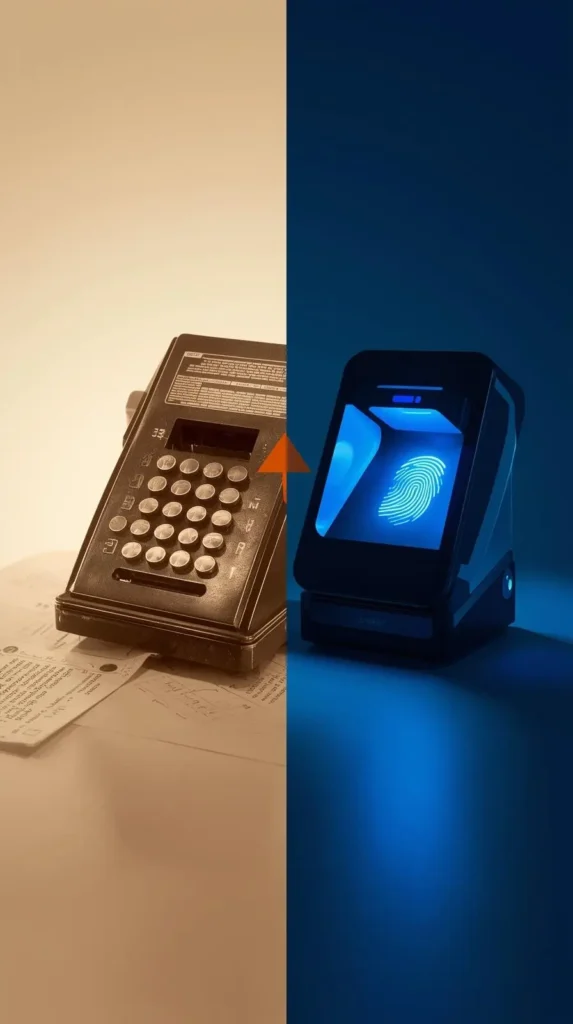As Sri Lankan organizations accelerate their digital transformation, the shift from manual attendance (Punch Card) systems to biometric and digital time tracking has become inevitable. To understand how this evolution impacts employees, compliance, and company culture, We spoke to Mr.Wajira Fernando, a Group Human Resources Manager at a Leading manufacturing Group in Sri Lanka.
He shares practical insights on challenges, best practices, and the future of attendance management in Sri Lanka.
Punch Card to Biometrics – Transforming Attendance in Sri Lanka’s Workplaces
Q: Sri Lanka has used punch card and manual registers for decades. What’s driving the change toward biometrics?
A:You’re right — punch card were reliable for their time, but they no longer suit modern business needs. The biggest driver for change is accuracy and efficiency. With thousands of workers spread across multiple sites — especially in apparel, retail, and logistics — manual systems can’t keep up.
Biometrics eliminate buddy punching, ensure real-time visibility, and reduce payroll errors. The pandemic also accelerated the shift, as companies sought contactless and automated attendance tracking to reduce crowding and handling of shared devices.
Today, both public and private organizations — from the Ministry of Transport to major apparel exporters — are exploring biometric systems integrated with payroll software
➡️ External Source: Sri Lanka postal
Q: What types of biometric systems are Sri Lankan companies adopting?
A:There are three main categories now in use:
- Fingerprint Scanners: Still the most common, especially in factories.
- Facial Recognition Systems: Gaining traction due to hygiene and speed benefits.
- Mobile Attendance Apps: Used by companies with distributed or remote teams.
For example, a Colombo-based logistics firm recently adopted mobile-based GPS attendance for field drivers. Meanwhile, large & Medium factories in around Sri Lanka use facial recognition devices at entry points synced with ERP systems.
Q: What are the biggest challenges during this transition?
A:There are three major pain points:
- Resistance to Change: Older workers often prefer the simplicity of punch card. Change management and awareness sessions are crucial.
- Technical Downtime: Power cuts or system glitches can delay attendance logging — a reality in Sri Lanka’s infrastructure.
- Data Privacy: Under the Personal Data Protection Act (PDPA) 2022, biometric data is classified as sensitive personal information. Employers must obtain consent and store it securely.
The key is communication — employees must understand that biometrics are for transparency and fairness, not surveillance.
Q: Some unions have raised concerns about employee privacy. How can HR teams address those fears?
A:Absolutely, and those concerns are valid. HR must take the lead in explaining:
- What data is collected
- How long it is stored
- Who has access
- How it’s protected
Transparency builds trust. I always recommend a written biometric policy in Sinhala and Tamil — so employees clearly understand their rights. Some companies even allow employees to view their own attendance logs via mobile apps. That openness changes the narrative from control to empowerment.
Q: Does biometric attendance actually improve productivity?
A:Yes, but indirectly. It’s not about “catching latecomers” — it’s about data accuracy. When attendance data is correct, payroll is on time, overtime disputes decrease, and HR spends less time on manual reconciliation.
For example, a leading apparel firm in Kandy reported:
- 70% fewer payroll disputes
- 40% drop in overtime abuse
- 25% reduction in absenteeism
These improvements build morale and productivity across the board.
Q: What about smaller companies? Can they afford biometric systems?
A:Good question. Cost used to be a barrier, but now even small businesses can adopt cloud-based biometric systems for as little as LKR 30,000–50,000 per terminal.
There are also subscription models where companies pay monthly instead of buying outright. For smaller teams, simple mobile attendance apps — like those offered by PayHere or HROne.lk — work perfectly.
The long-term ROI comes from saved admin hours and reduced payroll errors. (Punch Card)
Q: How can organizations ensure fair use and avoid misuse of biometric data?
A:They must align with both local labour laws and data protection standards. Practical steps include:
- Secure, encrypted servers for biometric templates
- Limited access to HR and IT admins only
- Regular data audits
- Employee consent forms
- Automatic data deletion after resignation or termination
Compliance builds credibility — especially for export firms under social compliance audits (like WRAP or Sedex).
Q: What’s next for attendance systems in Sri Lanka?
A:We’re moving toward integrated attendance ecosystems — combining biometrics, payroll, leave, and even AI-driven analytics.
Some large employers are testing AI-powered attendance forecasting, which predicts absenteeism patterns and suggests shift reallocation to avoid downtime.
I also foresee government institutions using biometric attendance to track service hours and improve accountability. This transition is part of Sri Lanka’s broader push for digital governance.

“The transformation from punch card to biometrics represents more than just a technological upgrade—it’s a fundamental shift in how Sri Lankan businesses value time, trust, and transparency. In the past, attendance tracking was a manual, error-prone process that consumed valuable HR hours and left room for manipulation. Buddy punching, lost cards, and illegible handwriting were daily frustrations that cost companies millions in productivity losses.

Mr. Wajira Fernando
Group Manager - Human Resources
Puwakaramba Group of Company








